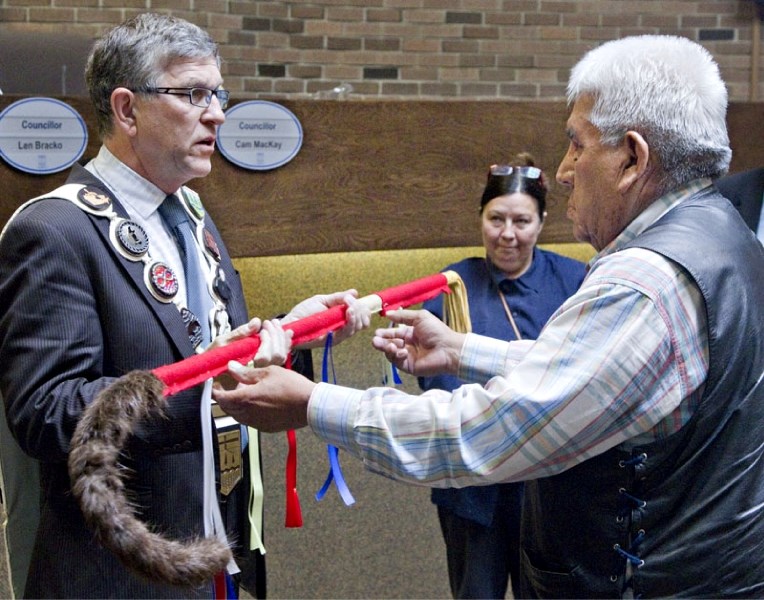An Alexander elder gave St. Albert the gift of co-operation this week in a ceremony involving a sacred staff.
Alexander elder Tony Arcand presented St. Albert city council with a hand-made staff Monday to commemorate the city's 150th anniversary. The event coincided with the city's declaration of June 21 as National Aboriginal Day in St. Albert. After purifying the staff in a smudging ceremony, Mayor Nolan Crouse and Arcand passed it back and forth several times in a symbolic show of co-operation.
The First Nations use these staffs to bridge the gap between societies, Arcand explains. "If we ever want to talk, that staff has to be present."
By passing the staff between them, people acknowledge they are equal in each other's eyes. "There's no higher and no lower. We're all on the same Earth."
This particular staff has a crook covered in beaver fur, Arcand says, representing the band's cultural links to the animal, as well as red, white, blue and yellow ribbons — the band's colours. It's different from an eagle staff, which is analogous to a band's flag and is exceptionally sacred.
The staff will be stored in the display case at St. Albert Place, Arcand says.
Celebration this weekend
The city is also holding its third annual Aboriginal Day Festival on Sunday at Lions Park. There will be traditional hoop dancers, Métis jiggers and fiddlers, Inuit throat singers, storytellers and more, says organizer Gwen Crouse, as well as traditional foods such as bannock and buffalo.
New this year is a trio of traditional aboriginal games taught by Karyn Gagnon, a member of the International Traditional Games Society, a group that seeks to preserve Native American games. First Nations tribes used these games in the past to build hand-eye co-ordination and endurance, she says.
The first is kickball, which was traditionally done with a ball made from hide. Kids would kick the fist-sized ball along a field and compete to see who could do a lap with it the fastest. This is tougher than it sounds, as the ball tends to land in gopher holes and has a tassel that makes it go all over the place.
She'll also have kids tie rings of willow to sticks to play ring-the-stick, the aboriginal equivalent to the old cup-and-ball game. "It probably originated with the Inuit," who used whalebone and animal skulls for their games, she says. Here, the goal is to flip the ring, skull or bone so it lands on the stick. Smaller rings make for tougher flips. The Inuit version is probably the toughest, she adds, as you have to hit a very small hole drilled into a big chunk of bone.
The last game is run-and-scream, which is more complicated than it sounds. Here, kids decorate a stick and take it to a start line. When they're about a metre from the line, they start running. "Once you hit the start line, you scream and on one breath, while screaming, you run as far as you can."
When they run out of air, the kids plunge their sticks into the ground to mark their distance. Whoever runs the farthest wins the match.
Scholars believe this game was used as a way to keep kids safe and noticed at powwows, Gagnon says, and to train them for buffalo hunts. "You'd scream and run and direct the buffalo to where you wanted them to jump."
It certainly builds your lung capacity, she adds, and is great for stress relief.
The celebrations start at 12:30 p.m. this Sunday with a grand entry. Guests are encouraged to bring their own chairs. For details, call Barry Bailey at 780-266-1836.



